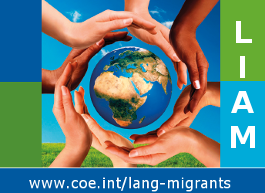Descriptions of CEFR Reference Levels for individual languages (RLD)
Framework descriptions by languages
The Common European Framework of Reference for Languages (CEFR, 2001) is the first and best-known of the instruments produced in the context of the projects conducted by the Language Policy Unit in order to pursue the perspective of plurilingual and intercultural education. But it is not the only one, far from it.
Reference instruments
Plurilingual education was subsequently developed “from the top” in the Guide for the development of language education policies in Europe (2007) which concerns all taught languages (and not foreign languages alone), and was taken to a further stage of elaboration with the Platform of resources and references for plurilingual and intercultural education (known as the Platform), present on the Council of Europe website since 2009.
However, the CEFR has also been developed “downwards”, so that the descriptors (generic and not language-specific) of the activities and skills are given substance by the linguistic material permitting their attainment in each language, at a given level of proficiency. This range of reference instruments received the designation of Reference Level Descriptions (RLD) for national and regional languages and was produced for German, English, French, Italian, Spanish, etc. These reference systems by language and level are naturally usable for the construction of courses such as those intended for adult migrants (see “The role of languages in policies for the integration of adult migrants – Concept Paper”, chapter 4).
From descriptors to words
For course organisers and teachers, the specifications of the CEFR may indeed have appeared too broad.
By means of the RLD, which have a similar function to that of the 1975-vintage Threshold Levels, we identify the forms of a given language (words, grammar...) command of which would correspond to the communicational, socio-linguistic, formal and other skills defined by the CEFR. These transpositions of the CEFR allow a shift from general communication skills to inventories of corresponding discursive genres (the CEFR’s textual types and genres) and to the characteristics of these genres, represented essentially by inventories of linguistic forms: general concepts, functions, “grammar” (understood in the morphosyntactic sense), by specific concepts/vocabulary, etc. Thus we move from a general frame of reference, common to different languages, to ones which are specific to each language, from a “communication” to a “language” orientation of teaching which is more immediately workable. The transposition of the descriptors to the forms is an undertaking of some theoretical complexity, whose results are to be handled with caution. It is guided by the analysis of narrative (aimed at characterising the narrative genres), the knowledge relating to natural acquisition of languages, and the expertise of designers of tests or assessments.
Choosing from the RLD inventories
The very open-ended character of these CEFR specifications by language has been explicitly subsumed in certain DNR which embody forms of variability built into the inventories, such as the option which designers are given to propose a word in either the production or the reception mode, indicative open-ended lists, the deliberate absence of distinction between ordinary oral forms and standard written ones, and so on. At all events, these frames of reference are not, any more than the CEFR, syllabuses to be applied, but instruments for devising tailor-made courses. Material should therefore be selected from them, especially lexical elements, to suit learners’ needs. This contextualisation is also necessary, though less so, for grammatical contents which must in any case remain in a very gradual time sequence. Just one of these RLD was specifically conceived for level A.1.1. speakers not conversant with literacy functions (Niveau A.1.1. pour le français) and comprises descriptors for access to written expression (p. 161 et seq.) which thus do not appear in the CEFR. But all these frames of reference are apposite for courses aimed at adult migrants, as these are distinguished from the others only by the nature of the language needs which they are required to meet.
JCB
Related resources
- Concept paper: The role of languages in policies for the integration of adult migrants, 2008, Jean-Claude Beacco.
EN FR
- Niveau A1.1 pour le français (publics adultes peu francophones, scolarisés, peu ou non scolarisés). Référentiel et certification ( DILF) pour les premiers acquis en français, 2006, Jean-Claude Beacco et alia, Paris, Didier
FR
- A Platform of Resources and References for plurilingual and intercultural education (CEFR, RLD, etc) – Language Policy Unit www.coe.int/lang-platform



